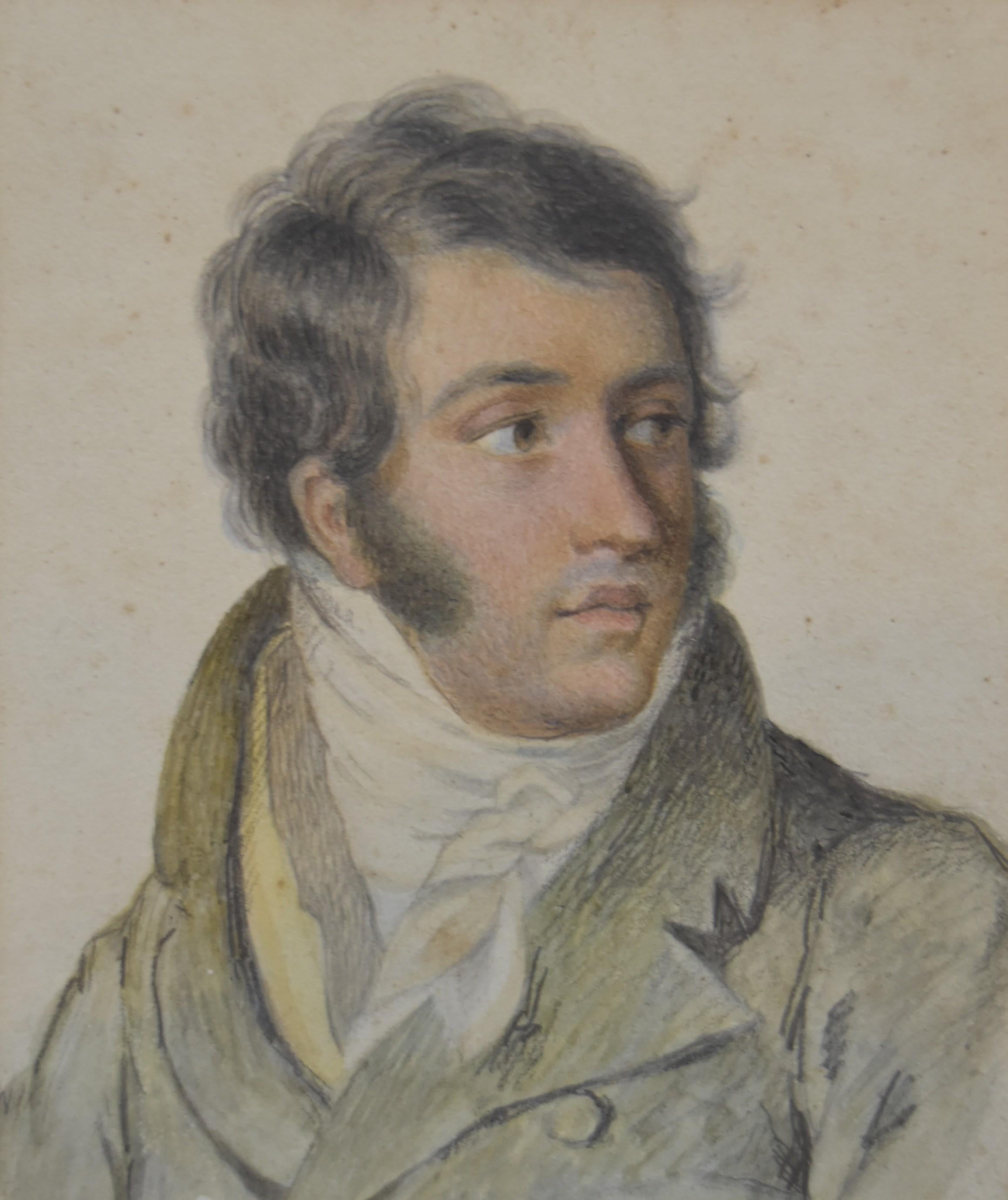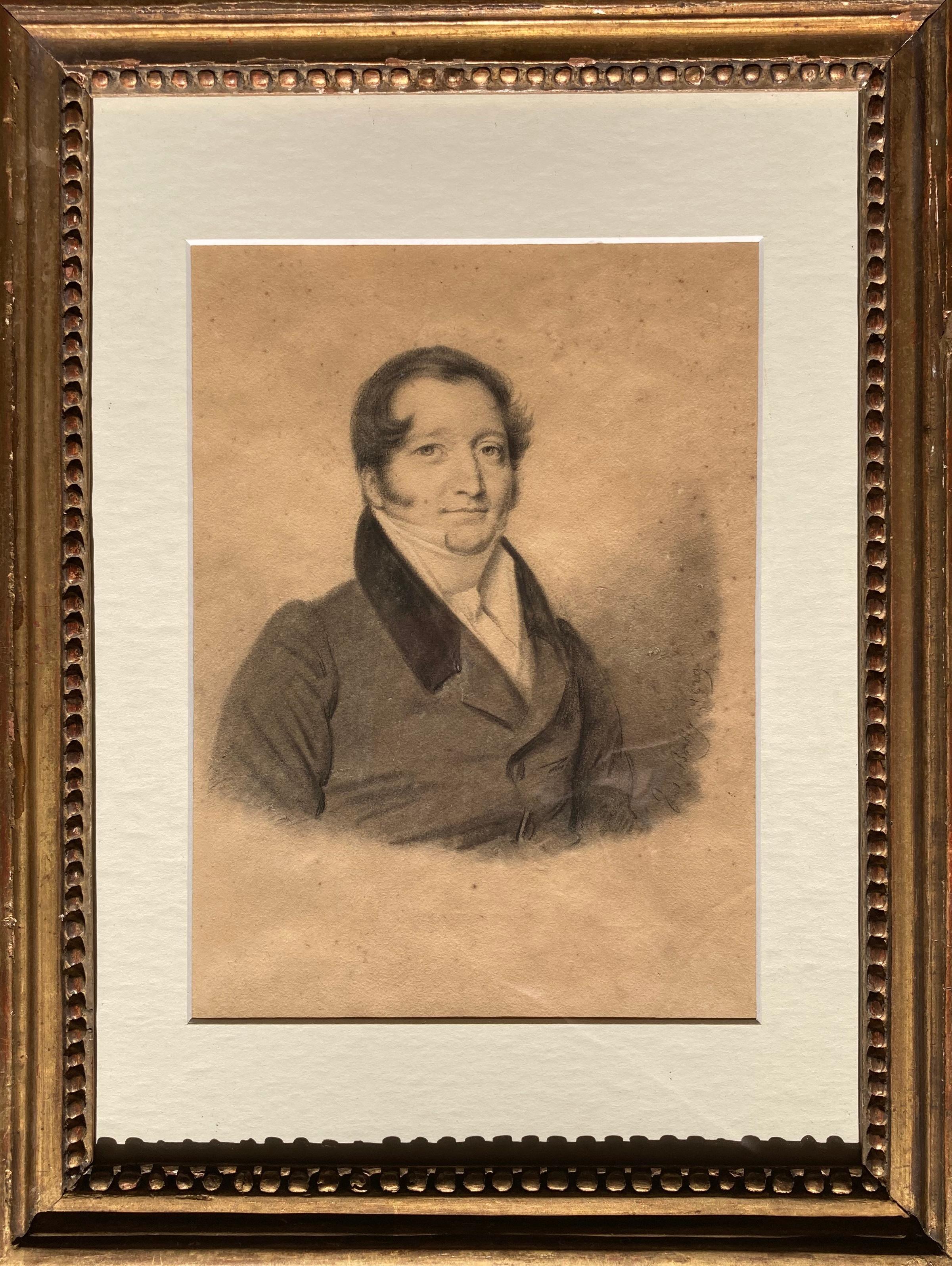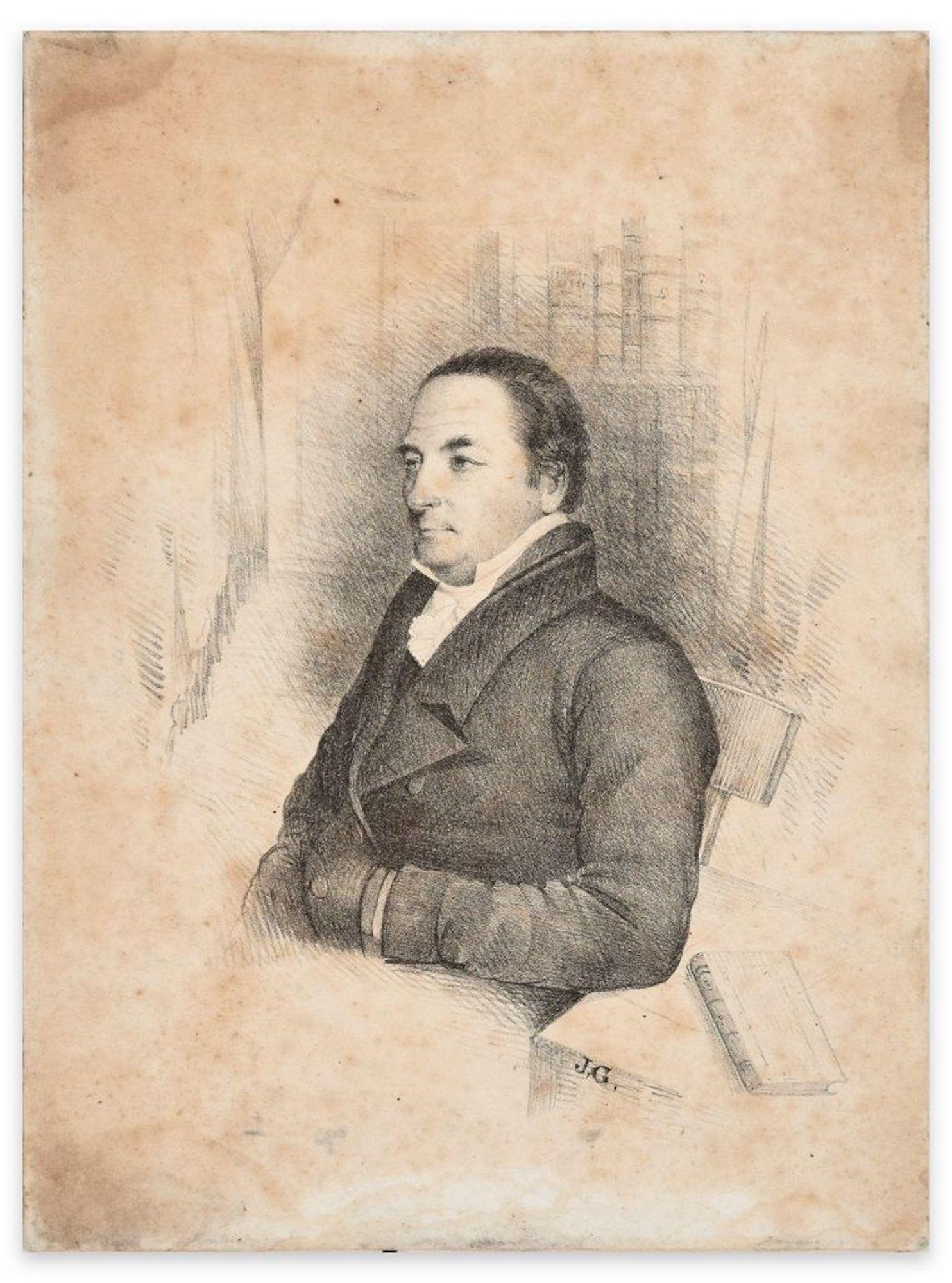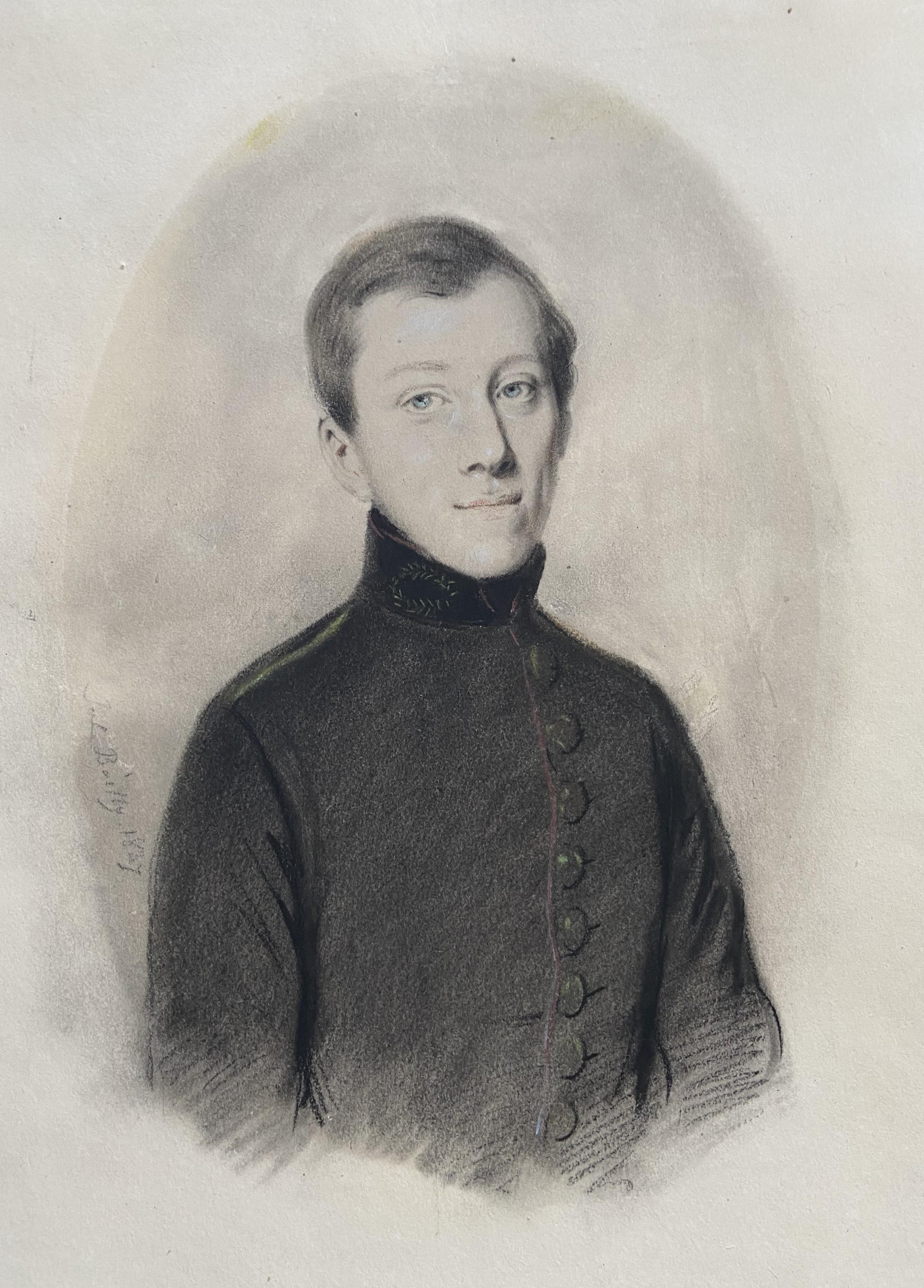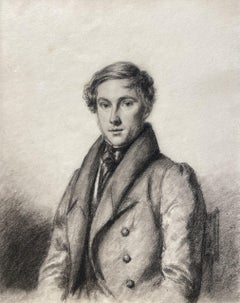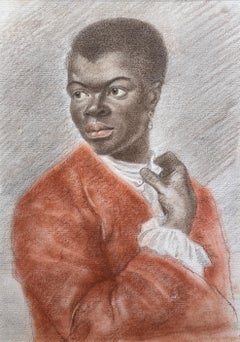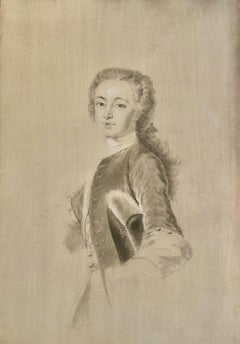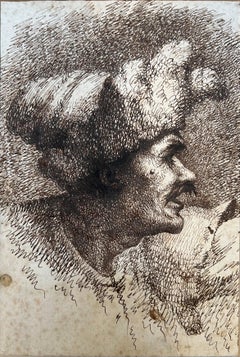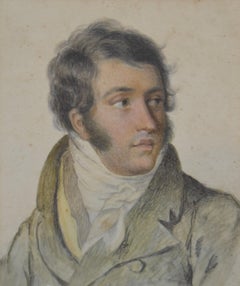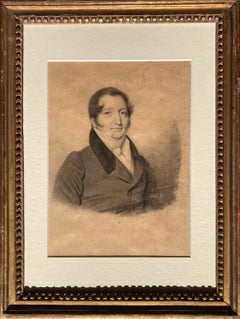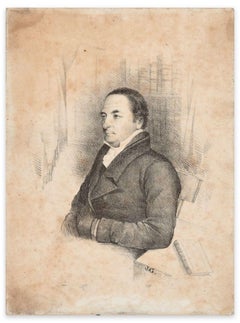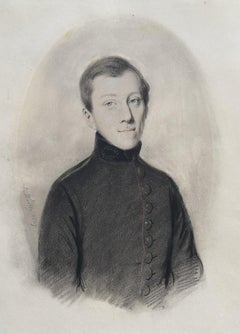Items Similar to Portrait of a Young Man, Charcoal 1800 French School, Romanticism
Want more images or videos?
Request additional images or videos from the seller
1 of 6
French SchoolPortrait of a Young Man, Charcoal 1800 French School, Romanticism1800
1800
$4,600
£3,516.94
€4,050.81
CA$6,446.01
A$7,196.36
CHF 3,770.79
MX$88,090.56
NOK 47,889.03
SEK 45,153.27
DKK 30,231.61
Shipping
Retrieving quote...The 1stDibs Promise:
Authenticity Guarantee,
Money-Back Guarantee,
24-Hour Cancellation
About the Item
Charcoal and grey wash on paper
Image size: 14 3/4 x 13 3/4 inches (37.5 x 36 cm)
Hand made gilt frame
Provenance
Private collection, Washington DC.
C.G. Sloan & Co., Sept. 1980.
This charcoal portrait depicts a young gentleman with plentiful curly hair and wearing an opened collared shirt. His head is turned right, towards a distinctive light source and he gazes off in this direction.
The work is clearly part of Romanticism, first defined as an aesthetic in literary criticism around 1800, gained momentum as an artistic movement in France and Britain in the early decades of the nineteenth century and flourished until mid-century. With its emphasis on the imagination and emotion, Romanticism emerged as a response to the disillusionment with the Enlightenment values of reason and order in the aftermath of the French Revolution of 1789. Though often posited in opposition to Neoclassicism, early Romanticism was shaped largely by artists trained in Jacques Louis David’s studio, including Baron Antoine Jean Gros, Anne Louis Girodet-Trioson, and Jean Auguste Dominique Ingres.
The sitters hairstyle is classically influenced cropped short everywhere but at the front with curls combed forward onto the forehead to resemble the Roman Emperor Titus. Regency hairstyles gave men a natural, romanticized look. Supporters of the French revolution rejected powder wigs and long hair because they were used by the aristocracy and to imitate roman republican heroes. Some supporters of the monarchy adopted short hair to remember those who had their hair cut before being beheaded. Only some men in the army (like some hussars that wore one or two braids) and the elderly kept their hair long.
Charcoal was a popular medium for drawing since the Renaissance, being used for preparatory purposes: to develop initial ideas, preliminary outlines, areas of shadow, or for squaring grids used to transfer a design to another surface. However, in the 19th century, artists began to use charcoal to make highly finished drawings.
Here, the textual effects that can be seen have been achieved by the artist through scraping, the mixing of water with the charcoal powder, stumping and various reductive techniques such as erasing. The composition of the work and the artist's choice to include a singular intense light source has allowed the charcoal to be exploited for its strength - the medium being used to produce lines that are very light and intensely black with the two being easily blended together. Indeed, the medium has always been prized for its ability to produce an interplay between light and shadow, known as chiaroscuro.
About the Seller
5.0
Vetted Professional Seller
Every seller passes strict standards for authenticity and reliability
Established in 2007
1stDibs seller since 2014
82 sales on 1stDibs
Typical response time: 2 hours
- ShippingRetrieving quote...Shipping from: London, United Kingdom
- Return Policy
Authenticity Guarantee
In the unlikely event there’s an issue with an item’s authenticity, contact us within 1 year for a full refund. DetailsMoney-Back Guarantee
If your item is not as described, is damaged in transit, or does not arrive, contact us within 7 days for a full refund. Details24-Hour Cancellation
You have a 24-hour grace period in which to reconsider your purchase, with no questions asked.Vetted Professional Sellers
Our world-class sellers must adhere to strict standards for service and quality, maintaining the integrity of our listings.Price-Match Guarantee
If you find that a seller listed the same item for a lower price elsewhere, we’ll match it.Trusted Global Delivery
Our best-in-class carrier network provides specialized shipping options worldwide, including custom delivery.More From This Seller
View AllPortrait of a Young Man, 19th Century English, Charcoal, Signed and Dated '1888'
Located in London, GB
Charcoal on paper, signed and dated '1888' bottom right
Image size: 9 x 7 1/2 inches (22.75 x 19 cm)
Period frame
The half-length portrait depicts the subject sat, wearing a white s...
Category
1880s Victorian Portrait Drawings and Watercolors
Materials
Paper, Charcoal
Portrait of a Young Man Original Charcoal and Pastel French 18th Century
Located in London, GB
French School
18th Century
Portrait of a Young Man
Charcoal and pastel on paper
Image size: 11 x 7 inches
Contemporary gilt frame
Category
18th Century Rococo Portrait Drawings and Watercolors
Materials
Paper, Charcoal, Pastel
Portrait of a Young Duke, 19th Century French Chalk Drawing
Located in London, GB
Black chalk, white smudge and highlights, on paper
Image size: 10 3/4 x 5 3/4 inches (27.25 x 14.5 cm)
A half-length portrait of a young Duke wearing a long wig...
Category
19th Century Portrait Drawings and Watercolors
Materials
Chalk
Sketch of a Man in Profile
Located in London, GB
Sketch of a Man in Profile
17th Century French School
Ink on paper
Image Size: 10 1/2 x 7 inches (26.5 x 17.5 cm)
Framed
Provenance
The estate of Joseph McCrindle
Christies Old Masters and British Pictures and Old Master Drawings Sale 12th December 2008
This highly worked picture shows us a man depicted in profile is seen interacting with a scene that extends beyond the boundaries of the paper's composition, the pen strokes intricately portraying the man's face, rendering a detailed, textured complexion. He points his left hand out to something in the distance, with a look of almost alarm.
The artist Giovanni Benedetto Castiglione (1609-64) did a series of oriental head studies.
The exotic headgear that he wears and this type of oriental head studies, had its principal source was of course Rembrandt, who etched many similar heads during the 1630s.
In the seventeenth-century Western European imagination, the turbaned figure represented the epitome of alterity: the Ottoman Turk. Ottoman costume...
Category
17th Century Old Masters Portrait Drawings and Watercolors
Materials
Paper, Ink
Graphite Study of a Head, Monogrammed Victorian Sketch, Gilt Fame
By Henry Perronet Briggs
Located in London, GB
Graphite on paper, monogrammed lower left
Image size: 6 x 6 1/2 inches (15.25 x 16.5 cm)
Contemporary style handmade gilt frame
Henry Perronet Briggs
Henry Perronet Briggs RA wa...
Category
Early 19th Century Portrait Drawings and Watercolors
Materials
Paper, Graphite
Anatomy of Man, Signed Graphite Nude Sketch on Paper, 19th Century French Artist
Located in London, GB
Graphite on laid paper, signed verso and paper watermarks and atelier stamp
Image size: 23 ¾ x 16 ¾ inches (60.25 x 43.5 cm)
Gilt Whistler frame
Leon Bellemont
Born on August 20, 1866, in the family home on rue du Grand-Cloître, Léon Bellemont studied from 1875 to 1883 at the Diderot college, where he was an excellent student. At the same time, he joined the municipal drawing school, where his exceptional predispositions were very quickly noted.
In 1884, at the age of 18, Léon Bellemont left Langres to join Paris and its National School of Decorative Arts, then the prestigious Ecole des Beaux-Arts. There, he followed the teaching of Léon Bonnat, a renowned portraitist, and obtained his first rewards and several prizes. It was in 1892, however, that his artistic career took off, with his first participation in the Salon des artistes français, where he exhibited until 1956.
A landscape and impressionist painter, particularly impressing marine worlds, Léon Bellemont stayed more and more regularly in Brittany at the beginning of the 20th century, where he painted numerous paintings. His notoriety grew, as did the profits from his sales, and the State itself ended up placing a few orders with him. His work “The Breton Faith” was, for example, acquired by the museum in Buenos Aires (Argentina).
Subsequently, always in search of inspiration, Léon Bellemont travelled extensively. He was in Bruges from 1907 to 1909, then traveled across France for several years participating in exhibitions. During the First World War, he settled in Algiers where he remained for several years. He then returned to Paris, worked extensively there and achieved great fame. A socialite, he frequented salons and regularly received his friends Jules Adler...
Category
Late 19th Century French School Nude Drawings and Watercolors
Materials
Laid Paper, Graphite
You May Also Like
France circa 1820, Portrait of a gentleman, black chalk and pastel drawing
Located in Paris, FR
France circa 1820
Portrait of a gentleman
Black chalk and pastel on paper
12 x 10 cm
In its original mount, modern oak frame : 25 x 22.5 cm
Category
1820s Romantic Portrait Drawings and Watercolors
Materials
Pastel, Chalk
$570 Sale Price
30% Off
Jules Boilly (1796-1874) Portrait Of A Man, Black chalk
Located in PARIS, FR
Julien Leopold BOILLY
Paris 1796-1874
Portrait of a man
First third of the 19th century
Pierre noire
Signed on the right
23,5 x 17 cm
38 x 29 cm framed
Small stains
Category
Early 19th Century French School Portrait Drawings and Watercolors
Materials
Laid Paper
Male Portrait - Original Pencil and Charcoal Drawing by French Artist Late 1800
Located in Roma, IT
Portrait of Man is a beautiful drawing realized by a French anonymous artist active in the early 19th century. On the lower right, there are the initials “J.G.” that do not allow the...
Category
Early 19th Century Modern Figurative Drawings and Watercolors
Materials
Charcoal, Pencil
Jules Boilly (1796-1874) Portrait of a young man, drawing signed and dated
Located in Paris, FR
Jules Boilly (1796-1874)
Portrait of a young man, in uniform,
signed and dated 1837 on the lower left
charcoal and heightenings of blue, red and white chalk on paper
27.5 x 21.5 cm
Framed : 41.8 x 36 cm
This drawing is a good illustration of Jules Boilly's own style, obviously very different from his father's realistic acuity. There is something softer, more velvety, lighter, and we can see it clearly in the way he renders the features of this young man.
Julien-Léopold Boilly (30 August 1796 – 14 June 1874), also known as Jules Boilly, was a French artist noted for his album of lithographs Iconographie de l'Institut Royal de France (1820–1821) and his booklet Album de 73 portraits-charge aquarellés des membres de l'Institut (1820) containing watercolor caricatures...
Category
1830s Romantic Portrait Drawings and Watercolors
Materials
Charcoal
Portrait of a Gentleman in a Redingote by student od Jean Louis David drawing
Located in Norwich, GB
An exceptional ink, wash and graphite portrait of a gentleman by Henri-Joseph Hesse, dating from circa 1820, the time of the Bourbon restoration in France. It depicts a dashing figur...
Category
Early 19th Century French School Portrait Drawings and Watercolors
Materials
Paper, Ink, Graphite
Paul Gavarni (1804-1866) Portrait of a young man, signed drawing
By Paul Gavarni
Located in Paris, FR
Paul Gavarni (1804-1866)
Portrait of a young man leaning on a Chair
Signed lower right
Black pencil on paper
23.7 x 17.6 cm
In good condition
Framed : 40 x 34 cm
This fine portr...
Category
1840s Romantic Portrait Drawings and Watercolors
Materials
Carbon Pencil
More Ways To Browse
19th Century French School
French Renaissance Art
Portrait Of Young Man
French Neoclassical Art
Roman School
French Renaissance Painting
19th Century British School
19th Century Portrait Of A Man
Romanticism Painting
French Art 1800
Portrait Of Emperor
Nineteenth Century Drawings
French Neoclassical Paintings
19th Century Portrait Gentleman
19th Century Portrait Young Man
French Wig
Regency Portrait Of
Jacques Louis David
